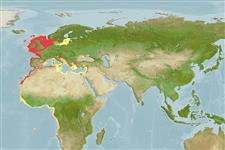Common names from other countries
Environment: milieu / climate zone / depth range / distribution range
Ecología
marino demersal; rango de profundidad 10 - 200 m (Ref. 4704), usually 10 - 100 m (Ref. 35388). Subtropical; 62°N - 18°S, 18°W - 42°E
Eastern Atlantic: Norway to Angola. Also known from the Mediterranean and Black Sea.
Length at first maturity / Tamaño / Peso / Age
Maturity: Lm 11.9, range 11 - ? cm
Max length : 25.0 cm SL macho / no sexado; (Ref. 35388); common length : 12.0 cm TL macho / no sexado; (Ref. 3397); edad máxima reportada: 8 años (Ref. 126653)
Espinas dorsales (total): 0; Radios blandos dorsales (total): 81-93; Espinas anales 0; Radios blandos anales: 74 - 82. Very thin body. None of the dorsal finrays are prolonged (Ref. 4704). Lateral line with a marked curve over the pectoral fin. Behind the pelvic fins two backward curved thorns. Body slender, translucent and shaped like a sole (Ref. 35388).
Live on mixed or muddy bottoms. Feed on small fishes and invertebrates (Ref. 4704).
Aldebert, Y., M. Desoutter and J.-C. Quéro, 1990. Bothidae. p. 1027-1036. In J.C. Quero, J.C. Hureau, C. Karrer, A. Post and L. Saldanha (eds.) Check-list of the fishes of the eastern tropical Atlantic (CLOFETA). JNICT, Lisbon; SEI, Paris; and UNESCO, Paris. Vol. 2. (Ref. 5979)
IUCN Red List Status (Ref. 130435)
CITES (Ref. 128078)
Not Evaluated
Threat to humans
Harmless
Human uses
Pesquerías: sin interés
Más información
ReferenciasAcuiculturaPerfil de acuiculturaRazasGenéticaElectrophoresesheritabilidadEnfermedadesProcesamientoMass conversion
Herramientas
Special reports
Download XML
Fuentes de Internet
Estimates based on models
Preferred temperature (Ref.
115969): 7.4 - 19.5, mean 10.8 (based on 1350 cells).
Phylogenetic diversity index (Ref.
82804): PD
50 = 0.5000 [Uniqueness, from 0.5 = low to 2.0 = high].
Bayesian length-weight: a=0.00617 (0.00515 - 0.00738), b=3.08 (3.03 - 3.13), in cm Total Length, based on LWR estimates for this species (Ref.
93245).
Nivel trófico (Ref.
69278): 3.6 ±0.3 se; based on diet studies.
Resiliencia (Ref.
120179): Medio, población duplicada en un tiempo mínimo de 1.4-4.4 años (tm=3; tmax=7.5).
Fishing Vulnerability (Ref.
59153): Moderate vulnerability (36 of 100).
